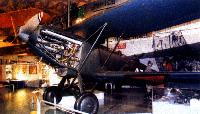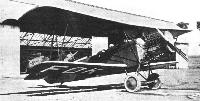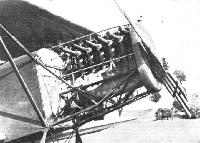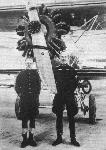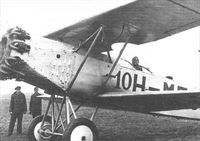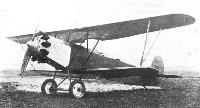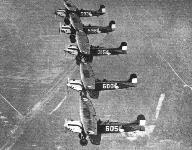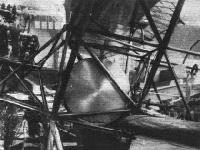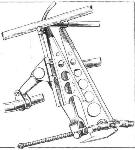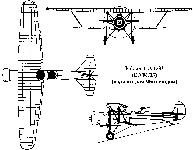
Описание
Страна : Нидерланды
Год : 1924
Двухместный самолет-разведчик, эскортный истребитель и легкий бомбардировщик
Варианты
- Fokker - C.V / C.VI - 1924 - Нидерланды
- Weiss - WM-16 Budapest II / WM-21 Solyom - 1933 - Венгрия
C.V / C.VI
Разведчик, легкий бомбардировщик и двухместный истребитель. Одномоторный биплан смешанной конструкции с неубирающимся шасси. Выпускался на колесном, лыжном и поплавковом шасси. Создан в КБ фирмы "NV Недерландше влиегтуигенфабрик Фоккер" под руководством Р. Плаца. Опытный образец C.V появился в 1922 г. Серийное производство начали на заводе "Фоккер" в Амстердаме в конце 1924 г. Впоследствии этот самолет строился по лицензии во многих странах мира. Различные варианты C.V выпускались заводами "Манфред Вайс" (Будапешт и Ферихеги, Венгрия), "Валтион лентоконетехдас" (Тампере, Финляндия), "Ромео" (Неаполь, Италия), "Хаеренс фливемаскин фабрик" (Кьеллер, Норвегия), EKW (Тун, Швейцария), "Дорнье" (Альтенрейн, Швейцария), авиамастерскими датских ВВС (Тойхугворксладерн), мастерскими CFM (Мальмслатт, Швеция). Всего построено свыше 1000 экз., в т.ч. более 600 - в Нидерландах. Экипаж самолета - 2 чел. Двигатель и вооружение в зависимости от модификации (обычно 2 - 4x7,69, бомбы до 100 кг).
Основные серийные модификации:
- C.VA, ближний разведчик с мотором "Либерти", вооружение 4x7,9 (4x7,69);
- C.VB, с крылом увеличенной площади, выпускался с моторами BMW IV, LD 12Db,HS 12Hb;
- C.VC, легкий бомбардировщик для Боливии с мотором HS 51;
- С.VD, ближний разведчик, полутораплан с новым трапециевидным крылом, вооружение 2 - 4x7,69(7,62);
- С.VE, легкий бомбардировщик, вариант C.VD с крылом увеличенной площади и N-образными межкрыльными стойками (вместо V-образных), вооружение 2 - 3x7,69(7,62) бомбы до 200 кг, выпускался также в варианте двухместного истребителя;
- FC.VE-400, вариант C.VE для эксплуатации в колониях с мотором "Лайон";
- С.VM/26, вариант С.VD датской постройки с моторами LD 12Db и вооружением 3x8;
- C.VM/33 (C.VE/33) с мотором "Пегасус" IIM2, усовершенствованный вариант C.VE для экспорта в Финляндию и Данию, самолеты датской постройки имели увеличенное вертикальное оперение.
На самолетах C.VD и C.VE в разных странах устанавливались двигатели LD12Db, BMW IV, BMW VI, "Юпитер", "Хорнет", "Конкверор", "Пантер", "Уосп", "Ягуар", "Меркьюри", "Лайон". C.VD голландских ВВС в 1934-35 гг. были модернизированы с заменой шасси и установкой двигателей "Кестрел" V. (как C.Vrr). В Дании C.VM/26 доработали под стандарт C.VE/33. В 1936 г. выпуск C.V почти повсеместно закончился. В Норвегии последние машины собрали в начале 1939 г.
Самолеты семейства C.V участвовали во многих вооруженных конфликтах по всему миру. Они состояли на вооружении в Нидерландах с апреля 1925 г., в Боливии - с 1925 г., в Дании - с начала 1926 г., в Венгрии, Швеции, Италии, Швейцарии - с 1927 г., в Норвегии - с 1928 г., в Финляндии - с марта 1935 г.
Итальянские Ro.1 (на базе C.VE) с конца 1927 г. применялись в Ливии против мятежных арабских племен. В декабре 1934 г. они совершили несколько налетов на абиссинские войска во время конфликта у оазиса Уал-Уал. С ноября 1935 г. по май 1936 г. итальянские "фоккеры" в широких масштабах применялись в войне с Абиссинией (Эфиопией) - как разведчики .легкие бомбардировщики и штурмовики. Позднее их использовали против эфиопских партизан.
Боливия использовала свои бипланы в ходе войны с Парагваем за район Гран-Чако в 1932 г.
К началу Второй мировой войны C.V сохранились в строю ВВС в Нидерландах, Дании, Норвегии и Финляндии. Норвежские самолеты использовались как дневные бомбардировщики весь период сопротивления агрессии Германии - с апреля по июнь 1940 г. Уцелевшие машины были эвакуированы в Финляндию, интернированы там и включены в финские ВВС. Датские C.VM были захвачены немцами в апреле 1940 г., в 1943 г. отправлены на Восточный фронт в качестве легких ночных бомбардировщиков. Голландские C.VD в мае 1940 г. внесли свой вклад в оборону страны как легкие дневные бомбардировщики и штурмовики. В частности, они штурмовали аэродромы Ипенбург и Валкенбург, где происходила высадка немецких десантников.
Финские самолеты участвовали в "зимней" войне с Советским Союзом; с ноября 1939 г. по февраль 1940 г. они действовали как разведчики и легкие ночные бомбардировщики в Карелии. Аналогичную работу возобновили и в июне 1941 г., а с февраля 1942 г. самолеты были переведены на ночную разведку и корректировку артиллерийского огня. Их использовали также для борьбы с партизанами. Большая часть финских C.V была выбита к началу 1943 г. С февраля 1945 г. уцелевшие самолеты законсервировали, но окончательно их сняли с вооружения только в мае 1946 г.
C.VE||
Размах:||15,3 м
Длина:||9,3 м
Моторы, количество х мощность:||1x780 л.с.
Взлетная масса, максимальная:||2450 кг
Максимальная скорость:||320 км/ч
Практический потолок:||9300 м
Дальность:||1140 км
Описание:
- C.V / C.VI
- Fokker C.V и C.VI
- Flight, April 1925
TWO NEW FOKKER MILITARY AEROPLANES - Flight, December 1926
The Paris Aero Show 1926 - Flight, March 1927
THE FOKKER C.V.-D.
Фотографии
-
Мировая Авиация 134
Швейцарские C.V-E закончили свою карьеру как буксировщики мишеней, прослужив дольше всех остальных машин данного типа.
-
Мировая Авиация 187
ВВС Дании. Данный Fokker C.V в середине 1930-х годов принадлежал 3-й эскадрилье Королевских ВВС Дании (Haerens Flyvertropper).
-
Мировая Авиация 187
Люфтваффе. Данный Fokker C.V-Е принадлежал 2-й эскадрилье 11-й ночной авиагруппы, действовавшей в августе 1944 года с аэродрома Ракла (Эстония). В октябре 1944 года перебежчики перелетели на самолете, принадлежавшем ранее датским ВВС, в Швецию. В 1947 году его вернули Дании.
-
Моделист-Конструктор Ближние разведчики, корректировщики и штурмовики Второй мировой войны
Биплан Фоккер C.VD стоит в экспозиции авиационного музея "Авиодом" в Амстердаме
-
Flight 1925-07 / Flight
The Fokker C.VI, with B.M.W. engine and nose radiator.
-
Flight 1925-07 / Flight
The latest type of B.M.W. engine in the Fokker C.VI.
-
Flight 1926-09 / Flight
NAPIERS FOR DUTCH EAST INDIES: The machine shown above is a Fokker, type C.V., one of a batch built by the Fokker works for the Dutch East Indian Military Air Force. It is a two-seater reconnaissance biplane with Napier "Lion" engine, and is credited with a top speed of 147 m.p.h., a ceiling of 21,300 ft., and a useful load of 2,112 lb. The famous Dutch designer shows a decided preference for British aero engines.
-
Flight 1933-08 / Flight
FOKKERS FOR DENMARK: The Fokker C.V-E (Bristol "Pegasus") being supplied to the Danish Army Air Service.
-
Jane's All the World Aircraft 1938 / 02 - The progress of the world in military aviation during the year 1937-38
A Fokker CV (Reconnaissance) of the Danish Army Air Force.
-
Моделист-Конструктор Ближние разведчики, корректировщики и штурмовики Второй мировой войны
Этот бывший датский CVM/33 использовался немцами как легкий ночной бомбардировщик Осенью 1944 г. советские войска захватили его на аэродроме в Таллине
-
Мир Авиации 1992-01 / А.Котлобовский - ВВС Финляндии в Зимней войне /Война в воздухе/
Разведчик Фоккер CV-E.
-
Jane's All the World Aircraft 1938 / 02 - The progress of the world in military aviation during the year 1937-38
Регистрационный номер: FO-66 [2] Fokker C.V. Observation Biplanes of the Finnish Air Force.
-
Мировая Авиация 187
Регистрационный номер: FO-66 [2], FO-67 Самолеты C.V-E финских ВВС в 1935 году. C.V-E - самый многочисленный вариант данного семейства.
-
Моделист-Конструктор Ближние разведчики, корректировщики и штурмовики Второй мировой войны
Регистрационный номер: FO-77 Фоккер С.VM/33 финских ВВС, 1943 г.
-
Мир Авиации 1992-01 / А.Котлобовский - ВВС Финляндии в Зимней войне /Война в воздухе/
Регистрационный номер: FO-80 Легкий бомбардировщик Блэкберн "Райпон" (Fokker C.V ???).
-
Jane's All the World Aircraft 1980 / Encyclopedia of Aviation - Aircraft A-Z - v3
Fokker C.VE with ski landing gear.
-
Flight 1928-08 / Flight
INTERNATIONAL APPRECIATION :This photograph shows a batch of Fokker aeroplanes outside the flying sheds at Schiphol aerodrome, Amsterdam. On the left are four C.V.'s for the Swedish Air Force. Next comes "Mr." Carbery's Universal. Next to that is an F. VII built for the Danish Air Traffic Co. An F. VII-3m for the Nederlandsch-Indische Luchtvaart Maatschappy follows, and in the foreground is an F. VII built for Poland. The C.V.'s and one of the F. VII's are fitted with "Jupiter"engines, while the F. VII-3m has three Armstrong-Siddeley "Lynx" engines. The latter machine is one of a batch to be used in the Dutch East Indies
Другие самолёты на фотографии: Fokker F.VII / C-2 / F.XIV - Нидерланды - 1924Fokker/Atlantic F.9 Universal / F.18 / F.XI Super Universal - США - 1926
-
Flight 1928-07 / Flight
THE "JUPITER" AND NOBILE'S RESCUER: Our picture shows Lieut. Lundborg, of the Swedish Army (right), with his mechanic and a Fokker C.V. fitted with a Bristol "Jupiter" engine. It was Lieut. Lundborg who rescued Gen. Nobile, and who was himself stranded with the remaining members of the Italia's crew when he damaged his machine on landing after his second rescue trip
-
Мировая Авиация 187
Датские ВВС эксплуатировали C.V-E голландской постройки. Модификации D и E - полуторапланы, нижнее крыло имело меньший размах.
-
Flight 1936-05 / Flight
The Nordic Cup Race: The Fokker S.6.A. (Bristol Pegasus) on which Lt. L. G. H. Thunberg, of the Swedish Royal Air Force, won the race
-
Air Enthusiast 1996-09 / Round-Out
Fokker C.V of the clandestine Hungarian Air Force carrying civil registration H-M??? The numeral is an LUH serial.
-
Aeroplane Monthly 1996-04 / Personal album. Civil
The Dutch-designed Fokker C.VD was licence-built in Hungary by Manfred Weiss, about 50 being used between 1928 and 1938. Powered by a 420 h.p. Walter Mikron Jupiter VI radial engine which gave it a top speed of 265 km/h, it was used predominantly as a trainer, but could carry a 120kg bomb load.
-
Air Enthusiast 1996-09 / Round-Out
WM Fokker C.Vd with ‘N’struts. Insignia is for an exercise conducted in the autumn of 1932. Note the Hungarian colours (red top, white and green) on the fin and rudder.
-
Flight 1925-11 / Flight
FOKKER C.V.D. A multi-purpose machine, the Fokker C.V.D. of the late 'twenties was one of a series of biplanes intended for fighting, reconnaissance, or artillery spotting. The version illustrated had the 400-h.p. Bristol Jupiter radial, but the 450-h. p. Hispano-Suiza could be fitted . A two-seat, the C.V.D. had a span of 41 ft. and a maximum speed of 158 m.p.h. Either two fixed guns firing forward plus two in the rear cockpit, or a single gun forward and another aft could be fitted.
-
Flight 1927-03 / Flight
The Fokker C.V.-D.: Three-quarter front view of the Dutch "general purpose" Military biplane, fitted with a 425 h.p. Siddeley "Jaguar" engine.
-
Flight 1928-07 / Flight
A FOKKER-"JAGUAR" COMBINATION: The Fokker C.VI Observation biplane, fitted, with an Armstrong-Siddeley "Jaguar" supercharged engine. This machine is a development of the Fokker C.V.D., previously described in "FLIGHT."
-
Flight 1928-02 / Flight
THE ARMSTRONG-SIDDELEY ABROAD: Successful Fokker-Armstrong Siddeley combination. C.VI reconnaissance machine, which is fitted with the 385 h.p. "Jaguar."
-
Мировая Авиация 134
C.VI представлял собой вариант C.V-D с новой силовой установкой, в небольших количествах он состоял на вооружении авиакорпуса Армии Голландии.
-
Flight 1925-04 / Flight
The Fokker C.VI is an artillery-spotter (two-seater), with Hispano-Suiza engine.
-
Flight 1926-12 / Flight
THE FOKKER C. V. can be supplied with a number of different engines, and can be quickly converted into a two-seater fighter, a reconnaissance machine, a bomber, or even a school machine.
-
Мировая Авиация 187
На самолетах C.V ставились рядные и звездообразные двигатели. На снимке голландский CV-D.
-
Flight 1929-02 / Flight Advertisements
The illustration shows formation of Fokker C.V.D. Two Seater Fighters of the Royal Dutch Air Force.
-
Flight 1929-07 / Flight
"FORMATING" AT ROTTERDAM: Capt. Versteegh's squadron forming up for their display
-
Flight 1928-07 / Flight
A VERY FINE SQUADRON: The two photographs show a flight of Fokker C.V.'s, which gave some excellent demonstrations of formation flying. Under the leadership of Capt. Versteegh, the Dutch pilots approach more nearly to British R.A.F. standards than any we have seen.
-
Flight 1926-12 / Flight
The Fokker Stand: On the extreme left a "nose" with "Jupiter" engine. Then a C.V.D. with Hispano engine and, on the right, the F.VII 3M with three Siddeley "Lynx" engines.
Другие самолёты на фотографии: Fokker F.VII / C-2 / F.XIV - Нидерланды - 1924
-
Flight 1934-08 / Flight
THE DANISH ARMY AIR FORCE STAND: The machine in the foreground is a Danish Fokker with Bristol "Pegasus" engine. Beyond it, on the left, can just be seen the de Havilland "Tiger Moth."
Другие самолёты на фотографии: De Havilland Tiger Moth / D.H.82 - Великобритания - 1931
-
Flight 1927-03 / Flight
The Fokker C.V.-D.: Two of the detachable power-plant units, by means of which various types of engines may be installed, easily and quickly.
-
Flight 1928-07 / Flight
The "dropping" petrol tank of the Fokker C.V.
-
АвиаПарк 2010-03 / В.Кондратьев - Статистика Блицкрига /Дискуссия/
Голландский истребитель "Фоккер" D-XVII (C-VD ???), поврежденный и захваченный немцами.
-
Flight 1933-11 / Flight Advertisements
THE ROYAL DANISH FLYING TROOPS have adopted the modified Fokker C.V.-E two-seaters as the standard army cooperation and reconnaissance 'planes. The engine chosen is the Bristol "Pegasus" RADIAL AIR-COOLED ENGINE
-
Flight 1928-07 / Flight
The tail-trimming gear on the Fokker C.V. The pilot rotates the worm shaft, which operates the crank arm that engages with the leading edge of the tail plane.
-
Моделист-Конструктор Ближние разведчики, корректировщики и штурмовики Второй мировой войны
Fokker C.VE/33 (C.VM/33) (вариант для Финляндии)
- Фотографии



